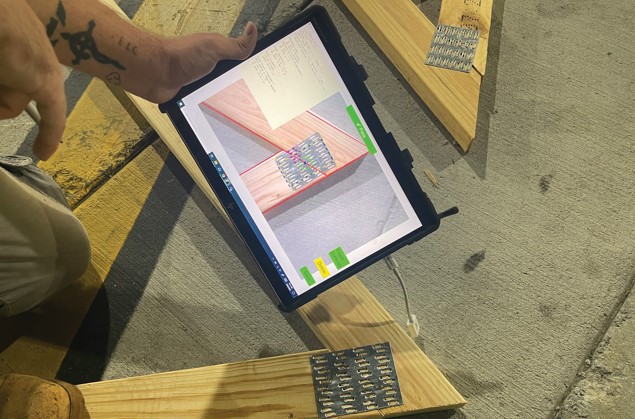A Better Mousetrap
SBCA’s new Digital QC drastically improves a dated process.
“The new Digital QC program is remarkable,” says Mike Honeycutt, manager of component systems-implementation and training for Builders FirstSource (BFS). “It solves all the challenges we used to face in conducting manual in-plant quality control inspections.” Mike is responsible for helping every BFS location seeking to use Digital QC get up and running. “It’s a monumental task,” Mike continues. “We started with five plants, but with the new program we suddenly have 15-20 sites that want to start using it yesterday. In fact, our entire western market wants to incorporate it as quickly as possible. Fortunately, the new program makes implementation a lot easier.”

This article will explore how the SBCA’s Digital QC program solves various challenges associated with the old manual QC inspections, as well as the opportunities created by this digital approach. Thanks to Mike’s vast experience, he can offer his valuable insights into this new technology.
Training
“One of the biggest hurdles with the manual inspection process was all the training it required,” says Mike. “If someone didn’t have a background in design and production, it took a long time to train that person to the point where he or she could do an inspection efficiently.” There are several factors to consider when evaluating each critical joint during a QC inspection, from lumber imperfections and their impact on plate holding strength, plate rotation and accurate plate teeth counts in each joint member, to plate embedment and member gaps.
Fortunately, the new software analyzes all of the complex factors within a matter of seconds with great accuracy. “Now I can take someone who is completely green and help him understand how to use the software to conduct thorough QC inspections in a matter of days,” says Mike. “Particularly for the younger generation, putting a tablet in their hands, a tool they are familiar with, makes the training process go more smoothly.”
The biggest training challenge now has nothing to do with the QC inspection. “The hardest part may be just getting them to hold the camera at the correct angle with a steady hand,” says Mike. “That’s a much easier problem to address.”

Accuracy
Not only is training easier, but the inspections themselves are more accurate. “The visual feedback from the tablet screen on where the joint members and plate should line up, and where they see the polygon overlay the plate on the screen, makes the analysis easy,” says Mike. “The green and red check marks also make verification very intuitive, and ultimately make the inspections objective rather than subjective, because the image the camera captures doesn’t lie.”
Efficiency and Effectiveness
It is important to note the software analysis is faster and more accurate. “The new Digital QC program can verify joints at a much faster rate than anyone could using the paper and pencil method,” says Mike. “When the first version came out a few years ago, it was very exciting. But it wasn’t perfect because it would max out the processing power of the tablet.” That would sometimes bog down the software, which impacted its efficiency. Fortunately, the new software does not have this issue. “With the new file formats, a single inspector can now load 100 truss design drawings on the tablet at one time and inspect to their heart’s content,” Mike continues. “It has really sped up the process considerably. The software also provides instant feedback: “The visual feedback loop improves the effectiveness of every inspection.” The end result is that BFS has an opportunity to get into more depth with each inspection and inspect additional joints beyond the minimum required by the TPI 1 standard. “It allows us to gather a larger sample size out of each plant and call out non-critical joint errors and fix them before they leave the facility.”
Money Savings
“With the new Digital QC software, we can effectively track plate rotation and missing plates on the backside of trusses, these are important issues for us,” says Mike. “A missing plate can result in back-charge from the framer in hundreds of dollars. Being able to catch those problems and fix them in the plant saves us real money. From that perspective, it’s easy to say the new Digital QC program is saving us money.”
Analysis
“With the old paper and pencil approach to in-plant QC inspections, I used to joke with SBCA staff that I’d love to get my inspection data review back before the middle of the next quarter,” says Mike. “It would take more than a month to get a picture of what the QC data was capturing. With the new software, not only do I get a lot of immediate feedback from the software, but I get my full QC report within a week. Getting that valuable data back in a meaningful timeframe makes a big difference.”
Biggest Advantage
According to Mike, “The biggest advantage of having this program running is the historical data we will eventually have at our fingertips. In just a few short years, we will have a mountain of digital data from QC inspections that will give us a clearer picture of the progression at each of our locations.” BFS will be able to quantify the impact of seasonal hiring on the quality of its product and the effectiveness of various training programs. “We could potentially even look at the impact of various lumber defects coming out of a particular mill or at how different equipment impacts product quality,” Mike explains. “The data can help us make better decisions because we can see what makes things better and what makes them worse.”
Commitment
BFS is committed to implementing the Digital QC program across the country. “It’s a big part of our SCORE certification through SBCA,” Mike concludes. “We are all in because we know it provides great value to our operations.”
